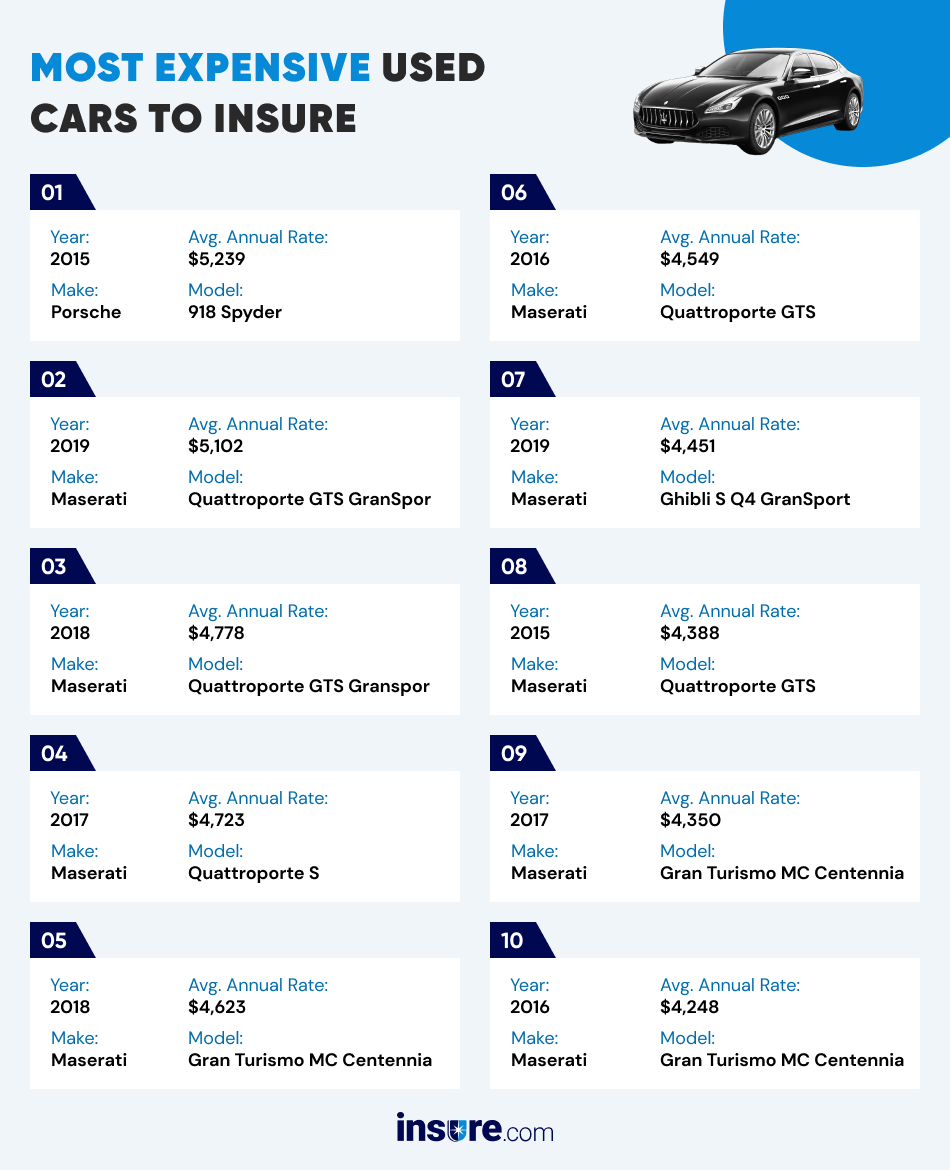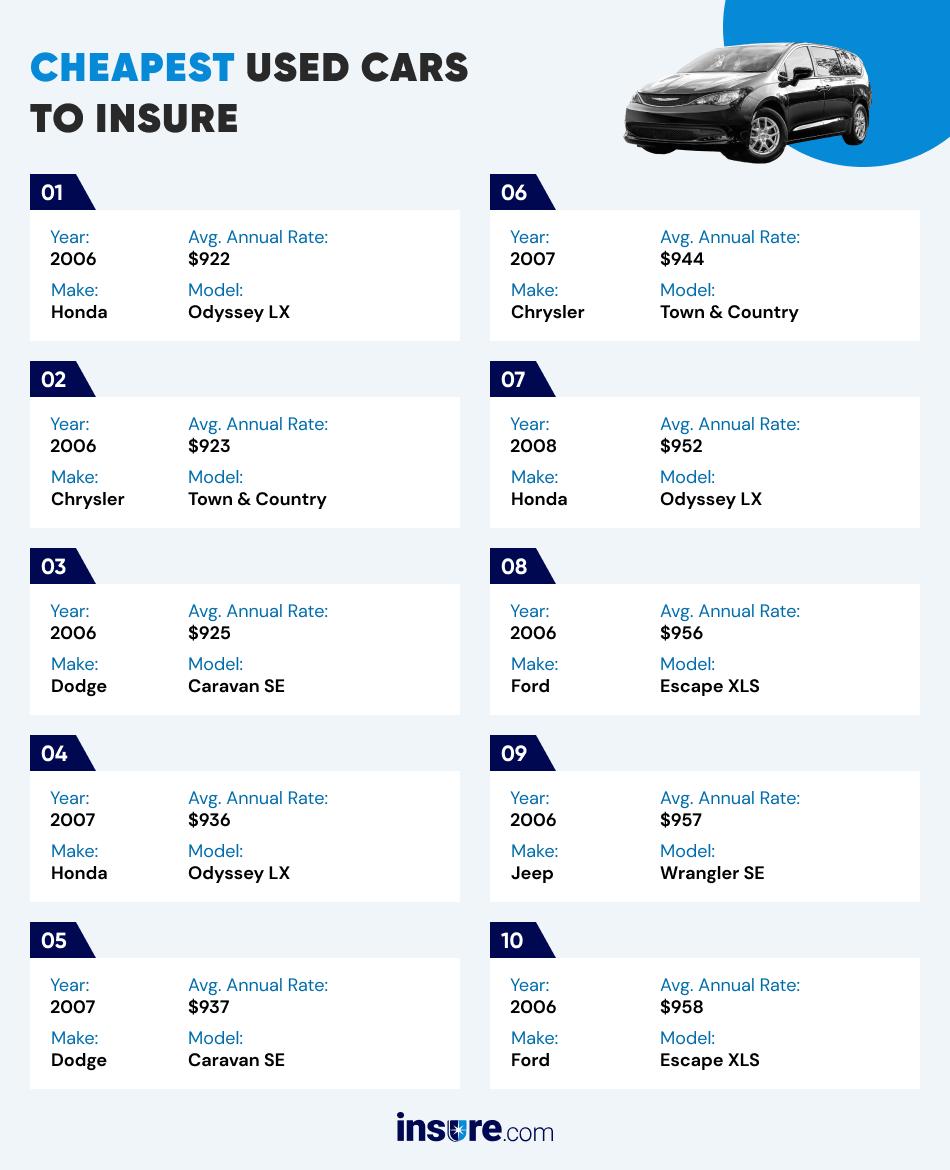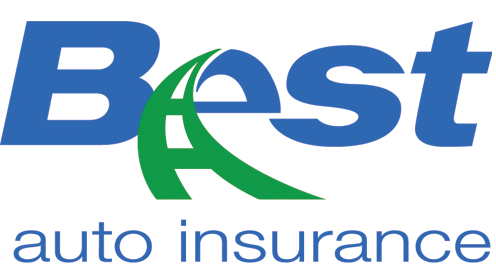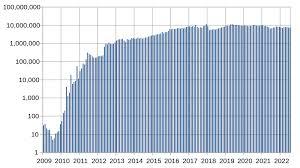There are many benefits to buying a used car: your car’s value has already depreciated, so you will not pay as much as a new model, and you may have more wiggle room to negotiate a sales price. Buying a used car can save you money on both purchases and auto insurance, but it is important to do your homework so you can find the right used car insurance protection for your situation.
There are some steps you can take when buying a used car to ensure that you get the car that you want and the right used car insurance coverage to protect it. Car insurance can be a major factor when buying a car, and you should always compare insurance quotes for any vehicle you are considering.
Per Insure.com data, the cheapest used car model to insure is the Chrysler Voyager L at $1,267 per year, whereas the most expensive used car model to insure is the Maserati Ghibli GranSport at a premium of $4,191 per year.
KEY TAKEAWAYS
- Depreciation of used cars typically makes buying used car insurance much more affordable than it is for new cars.
- The most expensive used cars to insure include the Maserati Ghibli GranSport, the Tesla Model S Performance, and the BMW M760i xDrive.
- Some of the cheapest used cars to insure include the Chrysler Voyager L, Fiat 500X Trekking, and Chrysler Voyager LX.
- To ensure you get the cheapest car insurance rates for your used car, always shop multiple quotes from the best providers.
How much does used car insurance cost?
Several factors determine used car insurance rates. Car insurance companies take into account certain insurance rating factors such as where you live, your driving record and credit score.
One of the most important factors to an insurance provider, however, is what car will be insured under your used car insurance policy.
“The used car insurance costs are lower, as they are less expensive to replace. If your vehicle is quite old and you have paid for it in full, you can lower your overall premium by dropping comprehensive and collision coverage.”
A family-friendly vehicle loaded with safety features will nearly always have cheaper insurance rates than a sports car regardless of whether the vehicles are used or new.
When we ran the numbers for full coverage for popular used vehicles between 2006 and 2021, we found the 2006 Honda Odyssey LX is the cheapest used car to insure, costing $922 a year for coverage.
On the other side of the equation, the 2015 Porsche 918 Spyder is by far the most expensive used vehicle to insure with an annual premium of $5,239.
Average used car insurance rates by model for 2006 to 2021
Average Insurance Rates for Your Used Vehicle
Most expensive used cars to insure (2006 To 2021)
- Porsche 918 Spyder
- Maserati Quattroporte GTS GranSpor (2019)
- Maserati Quattroporte GTS Granspor (2018)
Some cars are far more expensive than others to insure. These are the most expensive used cars to insure in 2021, based on full coverage of 100/300/50 liability coverage plus comprehensive and collision with a $500 deductible.

Show Table Data
QuickTake
Cheapest used cars to insure (2006 To 2021)
- Honda Odessey LX
- Chrysler Town & Country
- Dodge Caravan SE
If you do not have a lot of money to spend on car insurance, you could save a ton by opting for one of these models. These are the cheapest used cars to insure based on 100/300/50 liability coverage with a $500 deductible on comprehensive and collision coverage.

Show Table Data
Most expensive used cars to insure in 2023
When trying to determine how much is insurance for a used car, it helps to know the priciest vehicles to insure. These are the most expensive used cars to insure in 2023 with used car insurance rates by model.
| Rank | Model | Make | National average cost |
|---|---|---|---|
| 1 | Ghibli GranSport | Maserati | $ 4,191 |
| 2 | Model S Performance | Tesla | $ 4,165 |
| 3 | M760i xDrive | BMW | $ 3,903 |
| 4 | R8 5.2L V10 Quattro Performance | Audi | $ 3,897 |
| 5 | Model X P100D | Tesla | $ 3,892 |
| 6 | M8 XDrive | BMW | $ 3,858 |
| 7 | R8 5.2L V10 Spyder Quattro | Audi | $ 3,850 |
| 8 | R8 5.2L V10 Quattro | Audi | $ 3,830 |
| 9 | GT-R Nismo | Nissan | $ 3,820 |
| 10 | AMG GT R | Mercedes | $ 3,755 |
Some cars are far more expensive than others to insure. These are the most expensive used cars to insure in 2023, based on full coverage of 100/300/50 liability coverage plus comprehensive and collision with a $500 deductible.
Least expensive used cars to insure in 2023
To answer the question is insurance cheaper for used cars, we provide used car insurance rates by model. If you are looking for cheap car insurance, these are the least expensive used cars to insure in 2023.
| Rank | Model | Make | National average cost |
|---|---|---|---|
| 1 | Voyager L | Chrysler | $ 1,267 |
| 2 | 500X Trekking | Fiat | $ 1,298 |
| 3 | Voyager LX | Chrysler | $ 1,340 |
| 4 | Cooper Countryman | Mini | $ 1,436 |
| 5 | Encore Essence | Buick | $ 1,444 |
| 6 | RDX | Acura | $ 1,482 |
| 7 | Outlander Sport ES | Mitsubishi | $ 1,543 |
| 8 | Cooper Clubman S | Mini | $ 1,555 |
| 9 | QX60 Luxe | Infiniti | $ 1,846 |
| 10 | Stelvio Ti | Alfa-Romeo | $ 1,987 |
If you do not have a lot of money to spend on car insurance, you could save a ton by opting for one of these models. These are the cheapest used cars to insure based on 100/300/50 liability coverage with a $500 deductible on comprehensive and collision coverage.
Read more:
- Car insurance rates by state
- How much is car insurance a month
- The most expensive and cheapest cars to insure for 2023
Including car insurance cost in your buying budget
Don’t forget to take into account the cost of car insurance when deciding on a new ride. Insurance costs will often add 15% or more to your monthly car amount.
For example, if your monthly car payment is $400, even the cheapest monthly premium on our list, the Chrysler Voyager L, would be $106 a month or about 25 percent of your car payment.
Research insurance costs on any vehicles that you are serious about to ensure that you can truly afford the vehicle.
Our used vehicle insurance rates tool gives you an average insurance cost for specific vehicles, so you don’t have to call or go online to get a quote for every car you are considering. Receiving an online quote will not only help you decide what vehicle to buy, but it will also help ensure that both the car and its insurance are within your budget.
How much auto insurance coverage to buy for your used car?
Before getting quotes, map out what levels of comprehensive, collision and liability insurance you want. One question to consider is how much is full coverage insurance on a used car. This includes your liability insurance.
When you are legally liable for an auto accident, liability insurance covers injuries to people in another vehicle or their property.
Every state except New Hampshire requires at least a minimum level of liability insurance. Liability coverage is broken into two types: bodily injury and property damage. Though state minimums are much less, experts say you should get at least:
- $100,000 coverage for bodily injury per person
- $300,000 coverage for bodily injury per accident
- $100,000 property damage for your vehicle
It is always important to protect yourself with higher coverage since you will be held personally responsible if your limits are exceeded. Insurance companies also consider a model’s claims history when calculating rates. This means you will likely pay higher auto insurance rates if your car’s model is often stolen, you get into many accidents or you frequently get tickets. This is regardless of your driving record.
After settling on the liability amount you need, decide if you want comprehensive and collision insurance. These are the car insurance coverages that protect your vehicle.
Collision covers your car when it’s damaged after an accident with another vehicle or object. Comprehensive coverage covers thefts and damage caused by flooding, fire, vandalism and other causes beyond your control.
You’ll want to run the numbers to see whether that makes sense for your situation. A good rule of thumb is:
- If your car is less than 10 years old or worth more than $3,000, we recommend that you purchase full coverage.
- If your car is older and you wouldn’t spend your own money on mechanical repairs, it may be time to skip comprehensive and collision, and start saving for a replacement vehicle instead.
Keep in mind that thieves steal older vehicles more than new ones, so maintaining comprehensive insurance is a good idea unless the car’s value isn’t worth much. Some auto insurance companies offer you the option of carrying comprehensive insurance without collision insurance; others require you to buy both.
Remember to compare rates for the exact same coverage levels by using an apples-to-apples comparison as you shop around.
Rating factors: Vehicle
Rating factors: Value, Repair, Claims & Type
Value: Whether new or used, the value of the vehicle is critical to insurers when calculating your collision and comprehensive costs, since they may need to cover the cost if there is ever a total loss.
Repairs: The cost of repairs is also a consideration. A used car with newer, expensive tech will cost you more to insure than an older car with little or no tech. An old car that has hard-to-find parts and requires a specialist for repairs will likely cost more to insure — maybe even more than a new car that has parts and repair specialists readily available. The more an insurer may have to pay for repairs, the more you’ll pay in premiums.
Claims history for vehicle: If your insurance company has historically paid out a lot of claims for your model vehicle, it will cost more to insure. For instance, if your model vehicle is stolen more frequently, you’ll normally pay more than a vehicle that is not as popular with thieves.
Type of vehicle: Similar to new vehicles, a sports car normally costs more to insure than a minivan. If insurance companies find that certain cars are notorious for being driven fast and others slow, they will consider the claims and accident data available. Those vehicles will cost more to insure.
Other rating factors – non-vehicle:
When looking for a used vehicle, remember it’s not just the vehicle that insurance companies care about and rate you on. You will likely get better rates with:
- A good driving record
- Good credit score
- Driving experience (the more years licensed, the better)
- Driving 10,000 or fewer miles per year
- Having previous insurance coverage (a gap in coverage is not desirable, so if without a car for a few months, get a non-owner auto insurance policy)
Other factors of consideration include age, marital status, gender and location.
Though price is important, there is more to auto insurance than getting the cheapest rates. Make sure you get quotes with the same level of coverage so you can get accurate, comparable quotes from each insurance company. You’ll also want to read consumer reviews of the best car insurance companies to make sure you’re choosing one with stellar customer and claims service.
How long do you have to get insurance after buying a used car?
You’ll need auto insurance before you drive off the lot or away from the curb of a private owner, so it’s a good idea to contact your insurance company before making the purchase. That way, you can have that settled before you potentially forget and get into trouble. You don’t want the finance company placing “forced” insurance on your vehicle at a very high cost.
Also, be sure to make it clear if you are replacing a vehicle on your policy or adding an additional car to it, as that can make a difference if there is immediate coverage with your current policy.
If you don’t have an auto insurance policy already, then shop around and be ready to finalize and buy it when you purchase the car.
Used car prices are currently sky-high
If you are currently in the market for a used car, you may find yourself shocked by the prices. Used cars have gone up dramatically in price since the pandemic wreaked havoc on the economy.
According to the consumer price index, used vehicle prices increased sharply for the third consecutive month. Used cars and trucks are up 10.5% month-over-month in June; the Bureau of Labor Statistics (BLS) found this to be the largest monthly increase ever reported for used cars since it started publishing the report in 1953. And year-over-year, used vehicle prices are up an astonishing 45.2%.
Several factors have contributed to the rise in prices. Here are the main culprits:
Pandemic
When the pandemic hit, automakers shut down factories or ran them with a much smaller workforce, limiting the number of vehicles produced. As the pandemic has started to recede, demand for vehicles has increased dramatically, but dealers continue to have an inventory shortage. That has caused a price hike for both new and used vehicles.
Chip Shortage
Semiconductor chips power a variety of safety and driving features in cars, including backup cameras, emergency braking systems, airbags and power steering. Many chipmakers shut down factories when the pandemic hit, creating a lack of chips in the supply chain. Chipmakers have returned to normal production, but the high demand for chips has led to a continuing shortage for not only vehicles but also computers, TVs, cell phones and gaming consoles. Unfortunately, carmakers who cut back on chip orders last year are now at the back of the line.
Low inventory
Used car inventory depends on people buying new cars, turning in their leased vehicles, and rental car fleets being turned over, all of which have been impacted by the pandemic.
In the last year, new car inventory dropped dramatically due to supply chain issues and closed car factories. GM and other manufacturers have halted production on some car and smaller SUV models as they divert computer chips to pickup trucks and large SUVs.
In addition, when people stopped traveling, rental car companies’ business dried up, so there was no need to turn over their fleet. Without new cars available to buy, fewer people traded in their used cars, contributing to lower used car inventory, which also sent prices soaring.
“A stronger-than-expected economic recovery has us seeing a strong demand for both new and used cars,” says Matt Degen, editor for Kelley Blue Book. “It’s a simple issue of supply and demand.”
High demand
As new car prices have headed up, it has pushed some buyers into the used car market because they can’t afford a new car. Combine high demand with a limited inventory, and you have a recipe for high used car prices.
Experts expect elevated prices through the rest of the year and into the beginning of 2023. If you can afford to wait, you may want to put off replacing your vehicle for a year or two. (Although, if you have a used car to sell, now may be the time to get top dollar.)
Degen’s advice for consumers in the market for a used car is to do your research. “Before even setting foot on a dealer lot, make sure you have researched vehicles that will work for your budget, family and needs. Also, don’t expect a deal.”
How to buy a used car
Buying a used car takes homework, research and persistence, whether it’s your first car or an older model.
Here are a few tips on how to shop for a used car:
- Set a budget: Most experts recommend not spending more than 10% of your take-home pay on a vehicle. If your budget is tight already, you may want to lower that number to 8%.
- Decide what kind of car you want: Buying a used car isn’t always that easy and usually means searching databases, online forums and local car lots to find what you want.
- Contact the dealership for help: You can usually list the features you want to the dealership, and the dealer can then search for the make, model, color, and features to find the right car for you. Once you find cars you’re interested in, be sure to take it for a test drive to ensure it is the right vehicle for you.
- Research vehicle history: Most states don’t have the same “lemon law” consumer protections that apply to new cars, so you should take extra steps to review the vehicle’s history. Obtain a vehicle’s history report to make sure there aren’t any red flags. You can also read reviews from other drivers to learn about any issues and see the car’s safety ratings and recalls by looking around online.
- Negotiate: Now that you are better informed, you have more wiggle room to negotiate the price. For example, a new car dealership may not be able to give you the price that you want on a new vehicle, but a used car dealer might be able to shave more money off.
Used car inspection checklist
You don’t know everything about a car’s past by looking at it, but the good news is there is a way to explore its history.
- Check the VIN: You can research a specific used car’s history by running the vehicle identification number (VIN). The National Insurance Crime Bureau (NICB) maintains a database called VINCheck, allowing consumers to check for a stolen or salvage vehicle. The VinCheck is free to consumers, and you can do a maximum of five searches within a 24-hour period.
- Purchase an NMVTIS report: You can use the VIN to check the National Motor Vehicle Title Information System (NMVTIS). This is a system that was created to stop the concealment of flood damage and other vehicle histories and protects you from buying unsafe vehicles, as well as potential title fraud. NMVTIS is the only national database that requires all insurance companies, salvage auctions, junkyards and auto recyclers to report loss and junk/salvage vehicles, according to federal law. An NMVTIS report must be purchased from an approved NMVTIS provider.
- Check the vehicle history report: You can also purchase a comprehensive vehicle history report, which will tell you a vehicle’s accident history, previous owners, correct odometer mileage, major repairs and warranties on the vehicle. This report also tells you the vehicle’s “lemon” status. Federal lemon laws cover new cars, but they can also cover used cars if the vehicle is still under warranty. A few states, including Massachusetts, Connecticut, New Jersey, New Mexico, New York and Minnesota, have stricter lemon laws for used cars, requiring dealers to offer warranties and take back vehicles that have problems.
- Talk to your dealer: If you are working with a major car dealership or car-selling site, most will provide you with a vehicle history for free. Otherwise, you could purchase vehicle history reports from companies like AutoCheck, CarFax, and VinAudit.
- Inspect your vehicle: You don’t need to be a car enthusiast to give the vehicle a close inspection. Look for things like dents, rust, wear and tear on tires, interior damage, and heat and air conditioning issues. You can also check the radio, power seats, power windows and other features for problems. In addition to visually inspecting the car yourself, it’s recommended by experts that you take the time and money to get a trusted mechanic to give the car a full review before buying it.a








